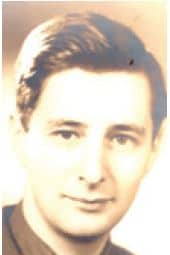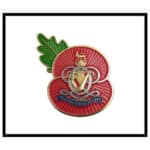Harford Lewis (“Jack”) White had already qualified as a solicitor and served for 4 years as a Trooper in the Inns of Court Regiment when he joined the Army in 1939.

After Sandhurst, he was commissioned into the 4th Hussars, which had been recommended to him as “the least expensive Cavalry regiment”. (On this he was reassured during his initial interview with the Commanding Officer, Lieutenant Colonel E.G.G. Lillingstone, who told him that if he found his mess bills too expensive, he would arrange a transfer).
In those days, the 4th Hussars had an unusual initiation procedure for new officers – on the first day they would be treated with civility and friendship, but for the next 4 weeks completely ignored and only spoken to on matters concerned with military duties; if they survived this period of ostracism unscathed, they were then accepted and welcomed as members of the Regiment. Jack passed the test and spent the next few months happily as a troop leader, first in a sabre squadron and then with Regimental HQ.
During the Greek campaign, Jack was posted to 1st Light Armoured Brigade HQ as Liaison Officer. Although he had a scout car at his disposal, his preferred method of transport was a motorcycle which was better at getting round road blockages. He told how his troop once shot down a low-flying Messerschmitt with their vehicle-mounted Bren guns and took the pilot prisoner, thereby saving him from certain death at the hands of the local population.
After Greece he rejoined the remnants of the Regiment which now occupied the Gezira racecourse, Cairo, re-forming as an armoured regiment equipped with Stuart (“Honey”) and Grant tanks. Whilst at Gezira, Jack and the other young officers were given early morning riding lessons by the RSM, “Chesty” Read,
on polo ponies left behind by the 7th Hussars and which did not take kindly to jumping fences under novice riders.
Following a difference of opinion with the Adjutant (Captain R.R. (“Porgy”) Archer), Jack was sent on a Junior Staff College Course and then posted as Staff Captain to the Greek Brigade in the desert. On one occasion he drove Prince Paul of Greece in his jeep to Divisional HQ where they both had tea with General Montgomery who greatly impressed Jack with his detailed grasp of the situation.
He rejoined the Regiment in time for training for Italy where he took command of ‘C’ Squadron in the Allies’ advance north. He recalled that at one stage Squadron HQ occupied a dilapidated farmhouse. During his first night there he awoke and saw, to his horror, a large rat sitting on his chest. After trying unsuccessfully to shoot it with his .45 revolver he procured a mosquito net from the SQMS which he used to discourage future visits by rodents which had been attracted by dead cattle and other casualties nearby.
After the assault on the Gothic Line as an armoured regiment, ‘C’ Squadron was re-equipped with Sherman Kangaroos for a troop-carrying role with 2/6th Queens and, with Jack leading the squadron from the front, played a major part in expelling the Germans from the Senio Pocket, taking over 200 prisoners.
At the conclusion of operations in Italy, he was awarded the Military Cross.
He left the Army in April 1945 and returned to civilian practice as a solicitor with the family firm, White & Co.
However, he continued to maintain strong links with the Regiment and, at the personal request of Winston Churchill, served as Honorary Treasurer to the 4th Hussars Regimental Association from 1953 until 1991. Thereafter, he continued as a Regimental Trustee, advising on investments for the Benevolent Fund and attending the dinners of the 4th Hussars Officers’ Dining Club until 2012.
Jack was born in London and educated at St Pauls where he both boxed and shot for the school. On one occasion before the War, he and his younger brother, Douglas who was also a very good shot, so impressed their Sergeant-Major at Bisley that they were asked to help train the other TA volunteers!
He married June Northcroft Frazer on 6th April 1946 (June died on 29th September 1980). He retired from London to Chilham, Kent where he was very much part of the community and a strong supporter of St Mary’s, the parish church, where he is now buried.
He died on 29 January 2018, 25 days after his 100th birthday.



